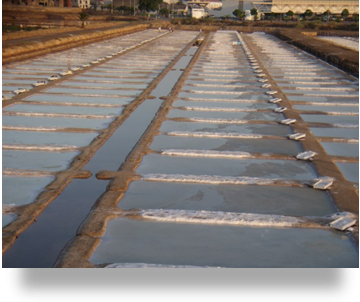Description: The Sal de Tavira / Flor de Sal de Tavira PDO is a sea salt manually harvested in the Tavira salterns, obtained from water of the Atlantic Ocean. It is a unrefined, non-washed after harvesting and additive-free sea salt. The product is commercially presented either as Sal de Tavira PDO (floccular crystals with a cubic form, breakable up to a point with one hand) or Flor de Sal de Tavira (much more sensitive to the friction, it is composed of very thin lamellae that e come apart into very small and very light crystals at the minimum contact with the hand).
Production method: The salterns are divided into three areas: storage; evaporation and brine concentration; and salt crystallization. Storage area acts as a water deposit and a decanter for impurities. Evaporation area has the function of raising the salt concentration, also allowing the elimination of the excess of some undesirable substances. Crystallization area, where crystallization of sea water occurs, is divided into small crystallizers, in order to enable the collection of salt to be done manually, working from their borders. The fleur de sel – a very thin lamella of salt that forms the surface – is harvested very carefully in order not to cause waves. The salt itself precipitates to the bottom of the crystallizers, being removed after the brine dries out.
Special features: Besides sodium chloride, Sal de Tavira / Flor de Sal de Tavira PDO has beneficial amounts of iodine and of numerous oligoelements present in the sea water.
Production area: The geographical area of production of Sal de Tavira / Flor de Sal de Tavira PDO is limited to the salterns of Tavira, located in the Ria Formosa Natural Park.
History: There are evidences that the producing of salt in Tavira dates back at least to the 4th century BC. The Phoenicians who settled in the region used it in fishery related activities or for food conservation in places distant from the coast. Tavira salt has since then been a part of the history of Portugal. In 1266, after the conquest of the eastern Algarve, D. Afonso III reserved for the Portuguese Crown all salterns existing or to exist in Tavira. They ended up playing an important role in the Portuguese expansion. The salt production assumed also a great importance for the fish canning and the chemical industries, which flourished in the region in XIX-XX centuries. Despite the decline of these industries, the production of salt in Tavira has never ceased, as proven by the salterns with a record of over 100 years in full operation, always using the same traditional processes preserved within the families through the generations.
Product specification (pdf)
Producer group
Rui Francisco Neves Dias
Control and certification body
Kiwa Sativa – Unipessoal, Lda.
Control plan
Control plan (pdf)
Publication in EU official journal
Regulamento de Execução (CE) nº 1168/2003 da Comissão – L310 20.11.2013
Publicação do pedido de registo (2013/C 132/13) – C132 09.05.2013
Publication in the Portuguese official journal
Despacho nº 3895/2012 – 16.03.2012
Aviso nº 18091/2011 – 14.11.2011



